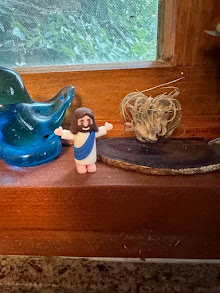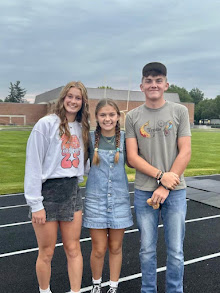
Ryan told us we should eat at the Range Cafe. He thought so highly of his meals there, he brought a cookbook home and fixed us supper ala Range one evening. Not wanting to miss out on a good thing, I looked up the address on our fall trip to New Mexico and we planned our lunch around the Range Cafe in Bernalillo. The entrance sported a Western mosaic, but the gotcha moment hit me after we were seated: I had been under the impression that "range" referred to the dry plains along the Rio Grande. Au Contraire! "Range" meant "stove" in my Midwestern parlance and there they were, arranged like a choir in the loft, overlooking the restaurant: play stoves of varied sizes, colors, ages. And near the middle, colored deep carnation pink, the spittin' image of the plastic stove my sister and I had in our play kitchen. We had two stoves and fridges, as I remember, both sets pink. One set was metal and pale pink and the other plastic and the color of tropical punch. We never had a life size set of appliances, though year after year we longed for the play kitchens in the Sears and Montgomery Ward toy catalogs at Christmas, but we wore our scaled down play kitchens out; maybe they survived us and were donated to the nursery at Sunday school, but its far more likely that the hinges failed and the cardboard backs collapsed.
We were lucky though; we had a fabulous child size hutch my grandfather made, and a whole houseful of doll furniture my grandfather built and my grandmother upholstered. The little china people were fragile and were born to a privileged existence; the father wore a bow tie, mother was dressed in a linen print dress, and the children had a nanny/nurse. I was always captivated by the family's appliances: a sturdy black and white gas range matched the one in our kitchen, but the wooden icebox clearly belonged to the same age as the pink cheeked dimpled family of the twenties. We could even set their table with a few blue enameled dishes from the past: a platter, the coffee pot. Laura and I had a doll house of our own, a two storied tin Colonial, but the plastic furniture it contained also stood a distant second to my mother's toys.
We had three Barbies, of the most vintage style. Barbie was the red haired "bubble-head" as we called the 'do. Sylvia was another "bubble-head" but in basic black. Ginger had curly bangs and a black ponytail; she may not have been a blonde, but she was the most glamorous of our three dolls. At that time,Barbies, in the generic sense, came wearing a one piece strapless bandeau swimsuit, pearl earrings, and toeless high heeled shoes. Heavy eye shadow and mascara was frequently augmented by whichever little girl was in charge of her makeup. These Barbies were nearly indestructible, with rigid straight arms and legs and heads that could pop off and on with little effort. My Grandma the seamstress kept Sylvia at her house as a model for several years, until she could make play clothes in her sleep. Every year for Christmas, we would receive a new outfit for our dolls as well as brand new toasty flannel nightgowns in matching or coordinated fabrics. We had a couple of purchased outfits: I remember a shiny green satin tight skirt with a flounced overskirt, topped with a white satin shell and a short matador type jacket. Well dressed women of the sixties wore hats and this Barbie outfit came with a little green pillbox hat that Jackie Kennedy could have worn. Actually, some of the prettiest outfits my grandmother sewed could have graced the White House: a floral sheath topped by a cape back tweedy coat with three quarter length sleeves, cuffs and scarf of the same floral print as the dress. As skirts grew shorter, Barbie kept pace, though it became more difficult for her to be modest since she couldn't bend her knees.
Though our Barbies never had a pink sports car, or boyfriends named Ken, they too lived in some pretty classy digs. My mother and father joined forces to create a splendid bedroom for the dolls. A flat white scarf box became a big bed, with a bedspread of trendy pink and brown trimmed with eyelet and topped with bolster pillows in a reverse print. There were two padded stools padded with cotton balls and upholstered with the same fabric. The mirror from one of my mom's compacts became the mirror on a four drawer dresser with working drawers and a tiled top. A small latched formica covered box, no doubt a refugee from some electrical part, was painted with a floral motif and became a trunk Wooden lids from perfume bottles, spools, and beads became lamps. The large open box had curtains at the windows and was papered with the same wallpaper that graced our bathroom. It was a masterpiece.
What we didn't have on hand in the way of furniture, we built ourselves with wooden blocks. These blocks and their wagon were made by my wood working grandfather and are still the stuff of roads, hangars, and runways to this day.
But the blocks were not only tables and chairs. Like most little girls, Laura and I were crazy in love with horses. We had Breyer horses in all sizes, some given to us, others purchased with coins carefully saved from weeding or other chores. We made a whole herd of horses from pipecleaners and yarn; our little town had a dime store where we perused the choices of black, browns, golds and other possible horsey hues. Our ponies were all named,from imagination or from fictional sources like Marguerite Henry's tales or Walter Farley's. Various dramas took place on our bedroom floor or even in the gardens during the summer. When my mom allowed, we got free use of all the artificial flowers she stored up and a whole bag full of colorful scarves. With these we created "Paradise", a wondrous place for our play herd. We were nothing if not anthropomorphic.
I don't remember much in the way of purchased toys. Our aunts and uncles bought us paints, paper, pastels, colored pencils, and books. I'm pretty certain our male cousins didn't get these same gifts! But we used them all, especially the Venus colored pencils, which drew bright deep hues without much pressure. All other colored pencils literally paled in comparison.
I still check out all the toy catalogs that fill the mailbox as Christmas nears. Some of the old toys are back, if indeed they ever left. We had a box of colored wooden tiles called Tangrams that we received as a gift....sure enough, these are still available. I can't wait to buy Colorforms for the kids; we spent many an hour making pictures with them. Even the Sunday School nursery had them, which really puts them back aways; we were pretty young when we were "old enough" to sit still through church. The church had an abbreviated assortment of Tinker Toys; we had some Lincoln Logs, but never enough to really build something substantial. But the best thing of all at the church was PlayDoh. I loved everything about it: the texture, the softness, the colors, the smell. Even though we were supposed to use 'home made' Playdoh for craft times, it was nothing close to the real thing. Did we have Playdoh at home? I don't remember. We did have real gray modeling clay which we carved and formed into little animals and dinosaurs which we painted and kept on our dressers til various appendages fell off.
Laura and I played games too....card games like Rummy and War. We learned to play cutthroat Hearts and Spades with my Granny and father. Granny was kind and funny; my dad used card games to teach life lessons about winning, losing, and the concept of no quarter. Part of the game was to keep a straight face even when you got stuck with the Queen. No handicap was given for age during Monopoly games either. My sister and I played endless games of Chinese checkers because we were evenly matched and we liked using my mother's old board with the marbles stored in tubes within the board.
These days Aaron is the engineer building structures and machines and vehicles with complicated attributes from Legos; Gabe is the farmer and pilot, gathering a stack of his favorite planes and trucks, heavy on the orange. Abbie is the artist with hieroglyphics penciled on a multitude of sticky notes and Lizzie is the domestic goddess, filling her hand bag with, well, anything and everything, talking on a domino (her phone) and laying her baby in the cradle in the living room. Best of all are the times a whole new world comes to life built by two, three or even four young imaginations. Then the toys, old, new, used, become merely props and not the main act in the play.
















